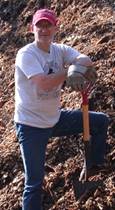David Rossiter (Netherlands)

Age: 60
Address: University of Twente , Faculty ITC, Enschede (NL) E-mail:
Position: Senior University Lecturer (since 1997)
1. When did you decide to study soil science?
While taking introductory Ecology at the NY State College of Agriculture ( Cornell University ) in spring 1971 I did a project correlating occurrence of Tsuga canadensis to soil map units of the Tompkins County soil survey. I became fascinated with the idea of soil classification and especially how a mostly-hidden resource could be reliably mapped. I got an A+ on the project; neither the ecologist nor I realized at the time that the map units with fragipans and perched water tables on hillsides (Volusia series) were most likely mapped by the presence of the hemlock!
2. Who has been your most influential teacher?
I was the last undergraduate advisee of Marlin Cline, one of the glorious generation of American soil geographers. I did a senior project with him on soil moisture and temperature regimes of the Dominican Republic (following a field trip) and also took a summer 'Agronomy tour' of the upper Midwest under his guidance. He taught me soil genesis, classification and soil survey interpretation. I learned practical field mapping from my party chief in North Carolina , Roy A. Goodwin. For my PhD I worked with Armand Van Wambeke, who taught me we only have one quality of work high and to make progress in soil science, you have to go outside it.
3. What do you find most exciting about soil science?
Soil is such a complicated system: everything is happening at multiple scales and mostly hidden away from direct view. Further, the soil cover is the result of a long history, which we can't directly observe. What excites me most is the challenge of making reliable predictions of soil functions over the landscape, which requires understanding how soils occur and evolve, all based on a tiny fraction of direct observations and a large dose of inference. This leads to the need for clever application of a wide range of empirical and process modeling techniques.
4. How would you stimulate teenagers and young graduates to study soil science?
Show them two things: (1) the intellectual challenge it is very difficult, requires multiple skills, diverse instrumentation, and above all clever inference; (2) the fun of field work being outdoors, going everywhere on the landscape, seeing the unexpected. If these don't excite them, we don't want them.
5. How do you see the future of soil science?
Positive in that the soil resource is ever more important, and is viewed from ever more angles by society. We're well away from soil science = soil fertility, and the environmental function of soils is more or less in the public conscience. Negative in that in many countries there is only ad-hoc or project work on soils, and thus little continuity and institutional memory. Positive in that the new possibilities for studying and mapping are exploding; negative in that many soil scientists are sometimes afraid to learn new things and to think creatively you can read articles published today that repeat work done in the 1910's.




